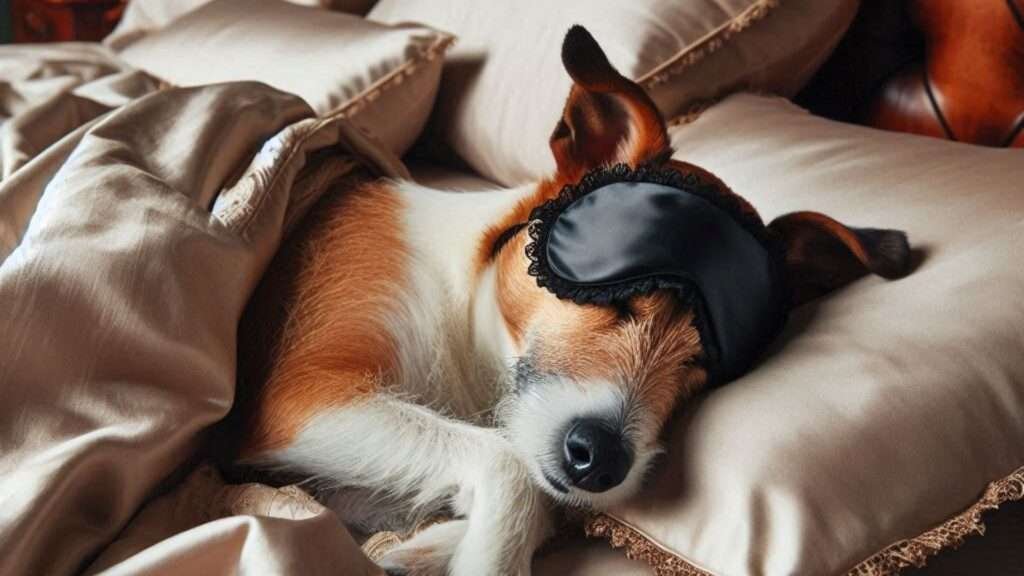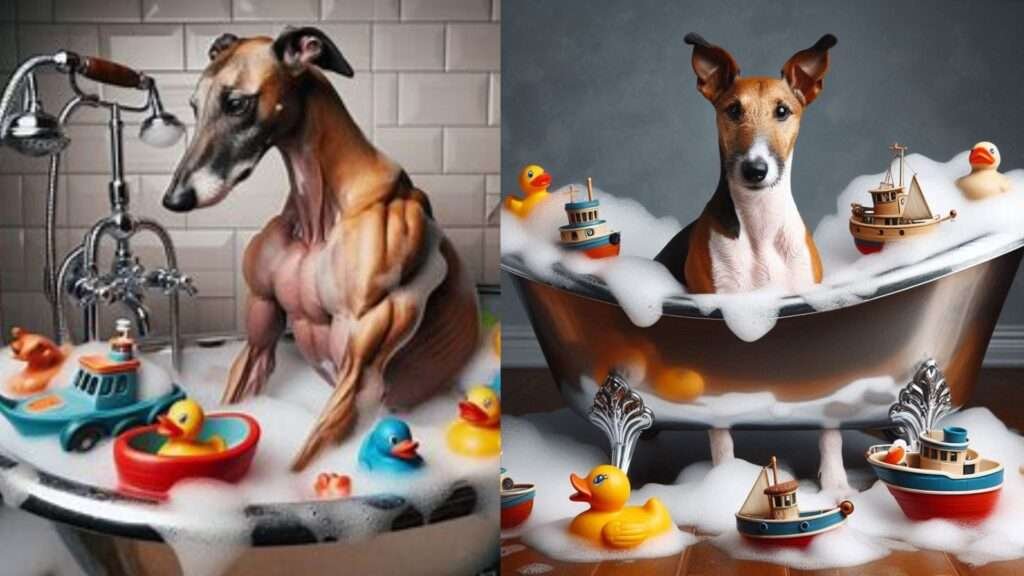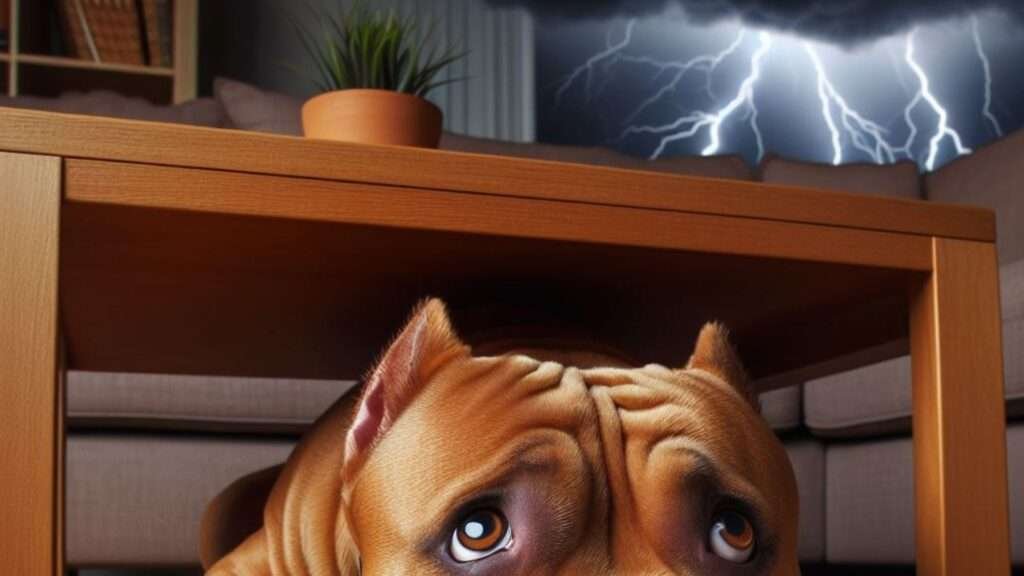It Is Time To Get Your Dog Their Own Bed.
Although your dog may disagree, Pet Parents require some personal space from time to time.
Many Pet Parents who have troublesome sleep issues or who are light sleepers let their pets lie on their beds every night, even though in these situations it might not be too good for their health.
Sleep disruptions are often difficult to recover from if you are a Pet Parent that has sleep issues. There is plenty of information readily available to you on the web if you are in doubt.
In any event, sharing a bed with your dog when you have sleep issues is quite commonly identified with lower sleep efficiency, increased awakenings, and disturbances related to your doggies many movements over the course of the night.
I’m sure every Pet Parent loves to spend time with their dog on the bed prior to sleep. When you are watching TV and cuddling up to your Dog, it’s a lovely time, even if your Dog has positioned itself between you and your partner.
Hygiene Concerns are a good reason your Dog to get their own bed.
If your Dog is sleeping on your bed, there’s a good chance that he/she has brought with them dirt, germs, fleas, ticks and all manner of things from your outside areas.
Unless you are impervious to health issues, I’m pretty sure nobody benefits from having parasites being introduced into your bed.
Surely, no person wants to sleep with a dog whose skin is covered in parasites or whose coat is laden with fleas and dirt.
Regular grooming and cleanliness are essential if you choose to co-sleep with your dog but the goal must be to get them their own bed.
The Obedience and Aggressiveness Changes are another good reason.
Some dogs may exhibit behavioural issues when allowed to sleep in the same bed at their Pet Parent.
I think it’s essential to consider obedience and aggressiveness factors thoroughly before letting your Dog sleep on the bed with you for too long and below are the reasons why.
Dogs think very differently to us.:
Dogs have complex social dynamics, and their behaviour can be influenced by their perception of hierarchy within the family.
Dogs are pack animals by nature and in a household; they often view their human family as their pack. Within this pack, they instinctively seek to establish a social order.
Historically, wild dogs and wolves lived in packs with a clear hierarchy. There was an alpha (the leader), followed by beta members, and so on. This structure helped maintain order and cooperation within the group.
What happens if your Dog decides that because he/she is sleeping on the King Size Bed, their social/pack standing is therefore elevated above your children?
There’s a chance that they might exhibit protective or territorial behaviour with regards to the parents bed.
This can lead to issues when the kids run into your room one morning to share the bed with you. I can share from experience what can happen and it could end up with one of the kids getting a nasty bite.
It is very hard to know how you will react to your dog biting one of your kids and I personally think that it is just far better to never allow yourself to be in that situation.
What we don’t understand is that Dogs are constantly observing interactions and behaviours to determine their position in the family hierarchy.
They pay attention to who gets attention first each day, who eats first in the morning and who gets to occupy certain key spaces within the home (like the bed).
So, as horrifying as the above situation of your Dog biting one of your kids might be, it is not something that you should feel immune to.
The fact that you let your Dog sleep on the bed as a matter of routine might have been the last piece of a mental puzzle that your Dog has recently put together.
Ever since it happened to me I’m very quick to point out to people that you should do what you can to prevent your Dog from perceiving itself as higher in rank than children.
What Is the Solution? What Can You Do?
Consistent Rules work rather well at work and with the kids, so be sure to do the same with your Dog.
Train your dog to understand boundaries.
Teach commands like “off” or “stay” to manage their behaviour and get them off your bed when you no longer wish them to be on the bed.
Purchasing your Dog their own Bed and have them sleep in their own designated sleeping area. This can help avoid family pecking order conflicts, ensure everyone gets a good night’s rest and nobody ends up on the wrong side of your Dogs thoughts.
Remember folks, every dog is unique, and their behaviour towards you, your partner, your kids and the sleeping arrangements can vary based on breed, personality, and individual experiences.
Observing your dog’s reactions and adjusting your approach accordingly will help create a harmonious living environment for everyone in your family.
You Have Now Decided To Buy A Dog Bed.
Even if you live alone, there may come a time where you decide that it is time for your Dog to get sleep in their own bed.
When the time comes and you’ve decided that your bed is now your personal space, you will first need to probably convince your furry buddy that your bed is not longer a dog bed.
Make sure that the Pet Bed you offer Fido as a substitute is very comfy and be sure to roll all over it and let your Dog know just how comfy his own personal doggy bed is and that you value it.
As much as you might try and convince your Dog that their brand new Pet Bed is where they sleep, they won’t necessarily make the connection.
For all we know, they might just consider the Pet Bed as a place for them to hang out during the day.
Stop Your Dog From Sleeping On Your Bed.
It’s not an easy job, the task of stopping your dog from sleeping on your very comfy bed takes time.
There are many ways of going about this task. The end result must be that Fido understands that he/she is no longer welcome on your bed.
They won’t understand for a while, after all, they’ve not done anything wrong.
Even when it comes to finding them a Bed that they enjoy sleeping on can be a tiresome process. Yep, it’s often harder than you might think to find a dog bed that they love.
Dogs are not all the same, and they will all have different needs for a comfortable place to sleep.
Purchasing Your Dog Their Own Bed.
When picking on a Dog bed, keep their personality, agility, health concerns, and available space in your home in mind.
There is no such thing as a one-size-fits-all Dog Bed; huge and tiny breed dogs, puppies, and old dogs all have different needs.
When shopping for a new Dog Bed, you might be asked questions like your dog’s age, weight, sleeping habits, whether they get hot easily, whether they chew objects, if they pee when they’re scared, or if they are covered in dirt and other filth 24/7 to help determine the perfect bed for them.
Just like when you’re buying a bed for yourself, you should examine what type of bed seems to make your dog the most comfortable, especially given how much time they will be spending sleeping on it.
Start off your bed search by measuring your dog from nose to tail and adding a few inches for safety. It is better if their bed is a little too big, since this will allow your dog to stretch out more. However, with so many various types and brands of dog beds to choose from, narrowing down your options will take some time.
The majority of dog beds include a foam base mattress or polyester fill. Solid memory-foam beds provide extra support and are available in a variety of hardness levels.
Polyester-filled beds are soft, fluffy, light, and prone to squish, but they can provide support for smaller and lighter-weight dogs if the material is tightly packed.
You should look for something hard enough to protect your dog’s spine and joints while yet being soft enough to lull them to sleep. To protect big, heavier dogs from sinking to the floor, they’ll require beds with a lot of solid foam.
Thin dogs, which lack the natural cushioning of plump thighs and butts, require additional support in the form of polyester fill or softer foam.
If you can’t feel the bed in person before buying it, user evaluations can help you figure out how dense the foam is and how good it is overall.
Some dogs prefer to sleep curled up in a ball, others prefer the feeling of resting in a cave or tunnel, and still others, mainly giant-breed dogs or those with double coats, prefer to sleep on something cool and airy.
Whatever you believe your dog’s preferences are, the bed you buy should promote calm, security, and comfortable slumber.
Plush coverings, soft bolsters, breathable materials, and even nooks where they can dig or hide a reward might entice dogs to choose their bed over the couch or a pile of clean clothing.
If you’re not sure which style of bed your dog prefers, pay attention to how they act.
You may try a cave like bed if they want to hide beneath the blankets. If they are sleeping on your hardwood floors or kitchen tiles, invest in a cooling bed.
If they are constantly circling and digging holes in the ground, then choose a bed with supports or one that is bagel shaped.
When Will You Know Your Dog Loves Their New Bed?
Eventually, the day will come where you give your dog a treat and he/she takes it to their bed to enjoy it. For my mind, that’s the day you know you’ve made the right Dog Bed decision.
Hopefully The New Dog Bed Lasts For a While.
Durability is something that gets determined over time. Now that you’ve been successful in purchasing a Dog Bed that they love, the next step is to see how long it lasts.
The more that your Dog loves their new bed, the more they will use it.
The new Dog Beds ability to withstand substantial wear and tear will certainly be put to the test.
Hopefully you have opted for a Dog Bed that has durable base materials like deep memory foam or aluminium framing, as well as cover materials like nylon, canvas, and micro-fibre that won’t snag, rip, or stain easily.
You should have also selected a Dog Bed that has a water-resistant cover for elderly dogs and puppies who are prone to weeing accidents. This will preserve the inside bedding from stains and odours.
Your dog’s bed will get dirty no matter what you do.
While you may be able to wipe dirty paw prints on the spot, urine stains that aren’t adequately removed will cause your pet to return to the same location to pee.
The new Dog Bed may not have been a good purchase if it’s difficult to clean. Check to see if the bed you buy has a removable machine-washable cover or if the entire thing can be washed.
The Process of Transitioning Your Dog from Your Bed to Their Bed.
For the last few years you may have been quite comfortable having your dog sleep on your bed next to you. It’s been a nice, cosy and comforting experience for the both of you but now it has to end.
Now that you’ve made the decision to change and you’ve purchased a Dog Bed that they love and it seems to be quite durable, we now need to make sure your decision works.
Below is a 6 step guide to help you make this transition:
Step 1 is introducing the new Dog Bed.
Place the bed in a location where your dog feels safe and comfortable, such as a quiet corner of your bedroom or a designated sleeping area in your home.
Make the bed inviting by adding familiar items like their favourite blanket or a toy.
Step 2 is encouraging positive associations with the new Dog Bed.
Help your dog associate their new bed with positive experiences.
Use treats, praise, and gentle encouragement to guide them towards the bed.
You can start by placing treats on the bed and rewarding your dog when they approach or sniff it.
Gradually increase the distance between the treats and the bed, encouraging them to step onto the bed to receive the reward.
Step 3 is about establishing a Bedtime Routine.
Consistency is key when it comes to establishing new habits. Create a bedtime routine that includes leading your dog to their bed at the same time each night.
Use a command or cue, such as “bedtime” or “go to your bed,” to signal that it’s time for them to sleep on their own bed.
Reward them with treats and praise when they follow the cue and settle down on their bed.
Step 4 is the hard one, ‘Making Your Bed Off-Limits’.
It’s important to clearly communicate to your dog that your bed is no longer an option for them.
Use positive reinforcement to redirect them to their own bed whenever they try to jump onto yours.
Avoid scolding or punishing them, as this may create negative associations with their new sleeping space.
Instead, be patient and consistent in redirecting them to their bed, rewarding them when they comply.
Step 5 is to provide comfort and security.
Make sure your dog’s bed is comfortable and suited to their needs.
Ensure that it is clean, free from any odors, and located in a quiet area of your home.
Consider adding a cozy blanket or a soft toy to provide them with a sense of security.
Dogs are more likely to embrace their own bed when it offers them comfort and a safe space to relax.
Step 6 is all about being patient and persistent.
Transitioning your dog to their own bed may take time and patience.
Some dogs may adapt quickly, while others may require more time to adjust.
Stay consistent with the routine and positive reinforcement, and avoid giving in to the temptation of allowing your dog back on your bed.
With time, they will learn to appreciate and enjoy their own sleeping space.
Remember This.
The goal is to create a positive and comfortable sleeping environment for both you and your dog.
By following these steps and providing love, patience, and consistency, you can successfully transition your dog to their own bed and establish healthy boundaries within your home.
Pet Bed Selection For Fussy Home Owners.
You may wish to purchase a Dog Bed that matches the decor of your home, if you are fussy about décor and you would like place a Dog Bed in the centre of your living room, then purchasing one that blends in with the décor will be a consideration for you.
If the bed is clearly displayed in an area where you spend a lot of your time, it is much more likely to become your dog’s preferred place to curl up. As such, you might as well have that Dog Bed blend in with everything else in the room.
Certain colours or patterns will always look better in one person’s home than in another’s. As a result, take your time and seek out beds in a variety of colours or prints and bring home a Dog Bed that you will love just as much as your Dog.











